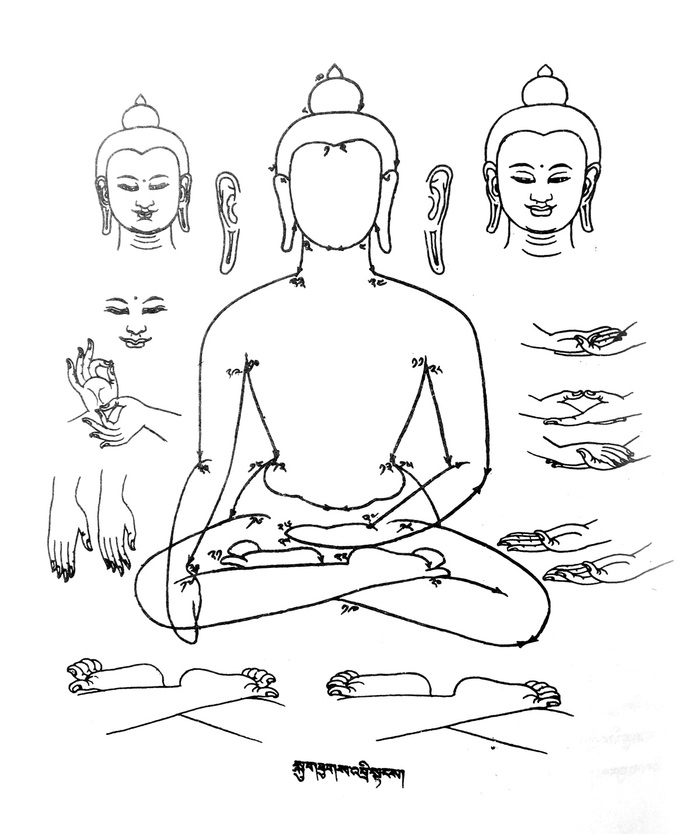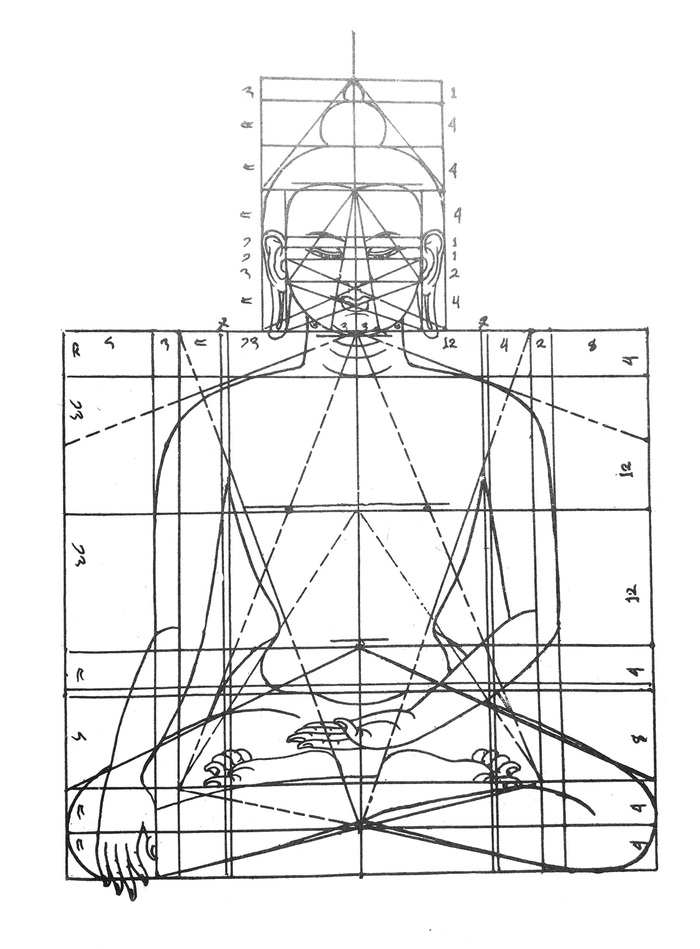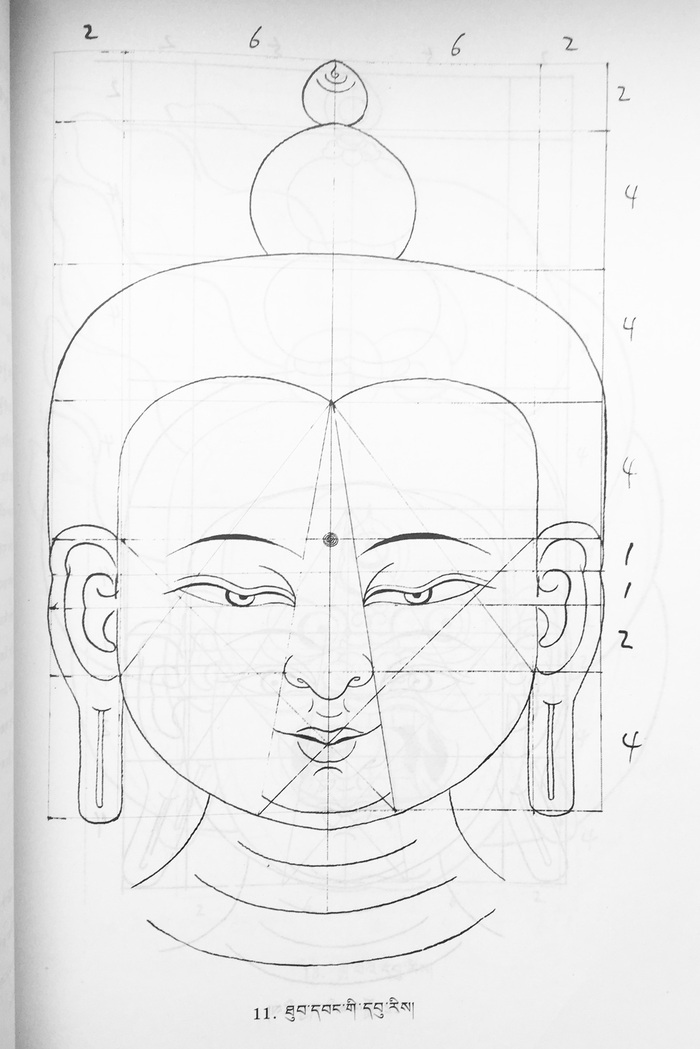Introduction
According to Mahayana, Buddhas can manifest simultaneously in innumerable physical forms to help innumerable limited beings throughout all universes. When these emanations are in the form of Sambhogakaya (longs-sku, a Corpus of Bodies of Full Use) or Supreme Nirmanakaya (mchog-gi sprul-sku, a Corpus of Supreme Emanation Bodies), they are complete with 112 physical faculties, namely the 32 excellent signs (mtshan bzang-po gsum-cu rtsa-gnyis, 32 major marks) and 80 exemplary features (dpe-byad brgyad-cu, 80 minor marks). Each of these signs and features has a corresponding cause in terms of constructive actions practiced in previous lives. The excellent signs are the indications of a great person (skyes-bu chen-po, Skt. mahāpuruṣa), while the exemplary features reveal inner qualities and serve to make a positive impression on the mental continuum of others. If we are aware of the causes of each of these features, then these physical faculties will show us very clearly the safe direction (refuge) to take.

Wheel-wielding emperors (’khor-los sgyur-ba’i rgyal-po, chakravartin emperors) are also considered “great persons” and their bodies also display the 32 excellent signs and eighty exemplary features. According to the abhidharma tradition of topics of special knowledge, these emperors appear during a world eon only when the human lifespan is decreasing from a countless number of years to 80,000 years. They wield a gold, silver, copper, or iron wheel of authority, depending on whether they rule over four, three, two, or one island-continent of a world-system.
Although wheel-wielding emperors share the same bodily features of a Sambhogakaya and Supreme Nirmanakaya Buddha, they lack the other qualities of a Buddha and thus are not fitting objects indicating safe direction. For example, a wheel-wielding emperor cannot emanate innumerable bodies simultaneously throughout all universes in order to benefit all limited beings. Further, according to Mahayana, a Buddha’s enlightening body pervades all Buddha-fields (sangs-rgyas-kyi zhing) and all Buddha-fields appear in every pore of a Buddha’s enlightening body. Wheel-wielding emperors lack such inconceivable physical qualities.
According to the anuttarayoga tantra explanations, since the mind of a Buddha is omniscient and therefore pervades all the countless universes and all knowable things within them, the enlightening body of a Buddha likewise pervades all the countless universes. This is because the enlightening mind of a Buddha is a clear-light mind, the subtlest level of mind; while a Buddha’s enlightening body is the subtlest energy-wind that is inseparable from that clear-light mind. Thus, wherever a Buddha’s clear-light mind pervades, a Buddha’s Corpus of Enlightening Bodies (gzugs-sku, Skt. rūpakāya, Form Bodies) also pervades. Wheel-wielding emperors certainly lack this quality of an all-pervading body.
Sources
In the Theravada tradition, the list of 32 excellent signs appears in The Sutta of the Excellent Signs (Pali: Lakkhaṇa Sutta) in the Long Discourses (Pali: Dīgha Nikāya). Mahayana has two traditions of their explanation. One derives from The Prajnaparamita Sutras (Pha-rol-tu phyin-pa’i mdo, Sutras of Far-Reaching Discrimination, Perfection of Wisdom Sutras). Maitreya follows this tradition in his Filigree of Realizations (mNgon-rtogs rgyan, Skt. Abhisamayālaṃkāra), as does Nagarjuna in his Precious Garland (Rin-chen ’phreng-ba, Skt. Ratnāvalī). These two renditions have only slight differences. The second Mahayana tradition of explanation of the 32 excellent signs derives from The Sutra Requested by the Girl Ratna (Bu-mo’i rin-chen-gyis zhus-pa’i mdo). Maitreya follows this tradition in his Furthest Everlasting Stream (rGyud bla-ma, Skt. Uttaratantra).
Here, we shall follow the explanation found in Filigree of Realizations, as explicated by Tsongkhapa (Tsong-kha-pa Blo-bzang grags-pa) in his Golden Rosary of Excellent Explanations (Legs-bshad gser-’phreng). We shall indicate the discrepancies with this account that are found in the Pali version.
The List of 32 Excellent Signs According to “Filigree of Realizations”

- On the sole of each of a Buddha’s feet and on the palm of each hand is the impression of a thousand-spoked wheel. The cause is a Buddha’s having always greeted and escorted his spiritual mentor and having had a selfless attitude of offering personal service to others.
- The soles of a Buddha’s feet are as smooth and level as the breast of a tortoise’s shell so that his feet are always firmly planted. This mirrors his having been firm in his promise to live in accordance with the verbal and realized indications of the Dharma and also his firmness in having safeguarded the three types of vowed restraints (vows). These are (a) the restraints for individual liberation (pratimoksha vows), (b) the restraints arising from being in a state of mental stability (bsan-gtan-gyi sdom-pa, Skt. dhyāna-saṃvara), and (c) the restraints from being untainted (zag-med-kyi sdom-pa, Skt. anāsrava-saṃvara). The first set include monks’ vows; the second are restraints from mental wandering, dullness, and so on, and arise from achieving absorbed concentration (ting-nge-’dzin, Skt. samādhi); while the third include restraints from the disturbing emotions and attitudes, and arise from realizing voidness (emptiness). Thus, the three sets of vows reflect the three higher trainings in ethical self-discipline, absorbed concentration, and discriminating awareness (wisdom).
- The fingers and toes of a Buddha are connected with a web of white light. This feature arises from his having practiced the four ways that gather others under one’s positive influence (bsdu-ba’i dngos-po bzhi): being generous, speaking kindly, giving encouragement regarding the points of the Dharma, and setting oneself as an example by acting in accord with those points.
- The skin of a Buddha, no matter how old he is, remains unwrinkled and as smooth as that of an infant nursing on his mother’s milk. This reflects his having always been generous with nourishing food and drink. In the Pali tradition, this sign is having tender hands and feet.
- Seven parts of his body are rounded and slightly raised. These are the tops of each hand, foot, shoulder, and the back of his neck. The reason for this is his having given others not only physical nourishment, but also other outstanding objects for enjoyable use, such as best quality clothing, and so on.
- The fingers and toes are extremely long. This comes from his having saved the lives of animals about to be slaughtered.
- A Buddha’s heels jut out broadly from his feet. This is from his having compassionately gone out of his way with compassion to help others, save their lives, and make them comfortable.
- The body of a Buddha is very straight and seven cubits tall. A cubit is the distance from elbow to fingertip; ordinary persons are usually four cubits tall. The cause of this extra height is his final and total ridding himself of the taking of any creature’s life. The Pali tradition refers to this sign as his body being straight like that of Brahma.
- His elbows and kneecaps do not stand out. This is from the intensity of his practice in having perfected the six far-reaching attitudes (six perfections) of giving, ethical self-discipline, patience, joyful perseverance, mental stability (concentration), and discriminating awareness (wisdom). In the Pali tradition and in some Tibetan variants, this sign is that his anklebones do not stand out.
- His bodily hair grows upwards, from his having engaged in constructive practices and having inspired others to do the same.
- His calves are well-rounded, like the legs of an antelope. This comes from his admiration for and well-rounded mastery of medicine, astrology, arts and crafts, and his having made use of these skills to benefit others.
- The arms of a Buddha are extremely long. When he sits cross-legged with his elbows at his side, his hands cover his knees so that his fingers can touch his seat. This reflects his never having sent away beggars empty-handed. The Everlasting Stream tradition adds that his arms are smooth, round and even in length.
- His private organ is recessed and remains concealed. This comes from his having strictly kept his pledges of secrecy and having never revealed what was meant to be held confidentially.
- His skin is luminous and golden in color, from his having offered soft and comfortable seats to others.
- His skin is likewise as fine and unblemished as purified gold free from all taints. This results from his having accommodated others in need of lodging and his having always provided excellent housing. In the Pali tradition, this sign is that a Buddha’s skin is delicate and smooth.
- A Buddha’s bodily hair curls clockwise, with never more than one hair growing from each pore. This is due to his having rid himself completely of mental wandering, busy work, and bustling confusion.
- He has a white treasure-like curl of hair (mdzod-spu, Skt. ūrṇākeśa) on his mid-brow that curls very tightly clockwise. When it is pulled from its tip, it extends a huge distance, and when released, it tightly recoils. This is one of the more difficult signs to achieve and is the result of his having served all his superiors with respect – parents, teachers, elders, spiritual masters, abbots, and so forth – and having respected them as his crown jewel. It also comes from his having helped others achieve one of the better states of wandering rebirth.
- The upper torso of a Buddha becomes progressively broader, like that of a lion. This comes from his having never humiliated or looked down upon others regardless of their status, power, wealth, and so on. It also results from his having never scolded others privately or in front of crowds, and having never belittled others’ beliefs or religious traditions.
- The top of a Buddha’s shoulders are round and well-connected to his neck, and his network of veins is not visible. This comes from his having freely given praise and encouragement to others and having acknowledged any action or person worthy of praise. In the Pali tradition, this sign is merely that his shoulders are evenly rounded.
- The area between a Buddha’s collarbone and shoulder is rounded, fleshy, and full, without any hollow depression. This is due to his having given others medicine and nourishing foods.
- A Buddha has a special faculty of taste that no matter what food he is given, it always tastes delicious. The cause for this faculty is his having nursed the sick, the old, and the infirm, and especially having cared for those whom others find distasteful and repulsive.
- The body of a Buddha is as stately and well-proportioned as a full-grown bodhi tree. This comes from his having built public gardens and parks for the enjoyment of others, and from having encouraged others to do the same. The Pali tradition uses the analogy here of a banyan tree.
- The top of his head has a crown-protrusion (gtsug-tor, Skt. uṣṇīṣa), made of radiant flesh, round and circling clockwise. When seen from a distance, it seems to be four finger-widths high, but upon closer scrutiny, its height can never be measured. This is the most difficult physical feature to achieve and is the result of his having always visualized his spiritual mentor on the crown of his head, as well as his having visited temples and monasteries and engaged in spiritual practices there.
- A Buddha’s tongue is extremely long and can reach the top of his head, his ears, and his chest. This comes from his having always spoken kindly to others with words of encouragement and having treated them as gently as an animal licking its young.
- His voice is melodious like that of an ancient song-bird, flowing without any effort, or like that of a Brahma. Whoever hears the voice of a Brahma is temporarily relieved of his or her problems. But the sound of a Buddha’s melodious and resonant enlightening speech can bring about full liberation from all fears. The cause for this faculty is his having communicated the Dharma in the individual languages of each wandering being.
- His cheeks are round and full like those of a lion, from his having rid himself completely of idle chatter and senseless speech. The Pali, Sanskrit and Chinese traditions explain this feature in reference to a Buddha’s jawbone or chin.
- The eye teeth of a Buddha are more brilliantly white than his other teeth are, because of his having given special praise to Buddhas and bodhisattvas and having shown them great respect.
- His teeth are all of equal length, from his having rid himself of the five wrong livelihoods and having always earned his living honestly. The five wrong livelihoods are obtaining money or material goods through (a) flattery, (b) pressure, (c) extortion – saying to someone that if he or she does not pay us money, we will expose their secrets to others, (d) bribery, and (e) pretense. The Furthest Everlasting Stream tradition adds that a Buddha’s teeth are also free of stains.
- A Buddha’s teeth are perfectly aligned and straight, with no gaps between them. This is from his having spoken the straight truth for three zillion eons and having been honest, never devious or crooked with others.
- His teeth are forty in number, with an equal amount on the upper and lower jaw. The cause is his having rid himself of divisive language and having always worked for unity and harmony among all living creatures.
- The black and white portions of a Buddha’s eyes are clear and distinct, with no red or yellow discolorations. This is the result of his having looked at others with compassionate eyes, having worked for their welfare, and having generated equal concern for all, whether their suffering was great or small. The Furthest Everlasting Stream tradition adds that the eyes of a Buddha are dark blue like a blue water lily, while the Pali tradition simply has that a Buddha’s eyes are dark blue.
- His eyelashes are beautiful and long, like those of a bull, with each hair distinct. This comes from his having regarded others without any attachment, hostility, or naivety, and his having striven to gain the full length of discriminating awareness to see the difference between what is correct and what is incorrect.
Variants in the “Furthest Everlasting Stream” Tradition

The Furthest Everlasting Stream tradition, as explained in A Commentary to (Maitreya’s “Mahayana Furthest Everlasting Stream” (Theg-chen rgyud bla-ma’i tikka) by Gyaltsab Je (rGyal-tshab rJe Dar-ma rin-chen), has several further differences from the Filigree of Realizations version. In this tradition, the following three pairs of signs from the list in Filigree of Realizations are counted each as one sign: numbers 7 and 9, 14 and 15, and 10 and 16. Three additional signs are then given:
- A Buddha’s body, free from all blemish, is surrounded with an aura of light, from his having practiced the ten constructive actions without ever feeling he had had enough,
- His neck has a stainless shape with three lateral curved lines like that of a conch, from his having given medicine and comfort to the sick,
- The hair on his head is sapphire-blue in color and without any faults, from his having had intense loving concern for all beings and having rid himself of resort to weapons.
Moreover, the order of the signs differs and there are also many variants concerning the causes for each sign.